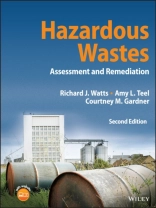Hazardous Wastes
An illuminating, problem-solving approach to source area analysis, environmental chemodynamics, risk assessment, and remediation
In the newly revised second edition of Hazardous Wastes: Assessment and Remediation, a team of distinguished researchers delivers a foundational and comprehensive treatment of all aspects of hazardous waste problems. The book offers two sections–one on assessment and the following on remediation–while exploring topics crucial to the study of environmental science and engineering at the senior or master’s level.
This latest edition includes a new emphasis on the chemistry of emerging contaminants, including perfluorinated compounds, 1, 4-dioxane, methyl tert-butyl ether, and personal care products. It also offers updated data on contaminant Threshold Limit Value, Reference Dose, Slope Factor, Reference Concentration, and Inhalation Unit Risk. New remediation chapters also provide many design problems, incorporating economic analyses and the selection of various design alternatives. Approximately 200 new end-of-chapter problems–with solutions–have been added as well.
Readers will also find:
* A thorough introduction to hazardous wastes, including discussion of pre-regulatory disposal and hazardous waste legislation
* Comprehensive discussions of common hazardous wastes, including their nomenclature, industrial uses, and disposal histories
* In-depth explorations of partitioning, sorption, and exchange at surfaces, as well as volatilization
* Extensive descriptions of the concepts of hazardous waste toxicology and quantitative toxicology
Perfect for senior- and masters-level college courses in hazardous wastes in Environmental Science, Environmental Engineering, Civil Engineering, or Chemical Engineering programs, Hazardous Wastes: Assessment and Remediation will also earn a place in the libraries of professional environmental scientists and engineers.
Tabella dei contenuti
Preface xv
Acknowledgments xix
Acronyms and Abbreviations xxi
About the Companion Website xxv
1 Introduction 1
Part I Assessment 35
2 Common Hazardous Wastes: Nomenclature, Industrial Uses, Disposal Histories 39
3 Common Hazardous Wastes: Properties and Classification 121
4 Source Analysis 161
5 Partitioning, Sorption, and Exchange at Surfaces 191
6 Volatilization 223
7 Abiotic and Biotic Transformations: Parallel Pathways 241
8 Contaminant Release and Transport from the Source 289
9 Concepts of Hazardous Waste Toxicology 317
10 Quantitative Toxicology 346
11 Hazardous Waste Risk Assessment 366
Part II Remediation and Treatment 385
12 Approaches to Hazardous Waste Minimization, Remediation, Treatment, and Disposal 387
13 Design of Sorption- and Partitioning-Based Treatment Processes 420
14 Design of Volatilization-Based Treatment Processes 472
15 Design of Abiotic Transformation-Based Treatment Processes 493
16 Design of Biotic Transformation-Based Treatment Processes 530
17 Mitigation of Residuals 570
Appendix References 668
Index 675
Circa l’autore
Richard J. Watts, Ph D, is the Boeing Professor of Civil and Environmental Engineering at Washington State University. He has published approximately 120 refereed papers related to hazardous wastes in various academic publications.
Amy L. Teel, Ph D, is a Research Associate Professor of Civil and Environmental Engineering at Washington State University. She has 25 years of research experience in hazardous waste remediation.
Courtney M. Gardner, Ph D, is an Assistant Professor of Civil and Environmental Engineering at Washington State University. Her research is focused on characterizing and applying the mechanisms driving microbial resilience to improve the efficiency of wastewater treatment and bioremediation.












